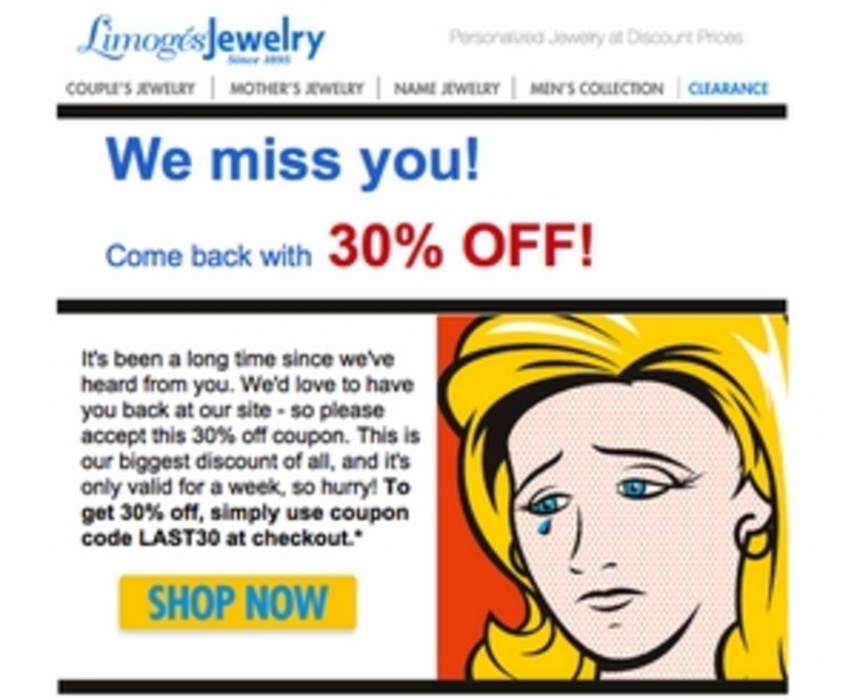Jon Ozaksut knew when he started in March that something was wrong. As the newly-minted e-commerce marketing manager at personalized jewelry retailer Limoges, he saw that revenue per email was on a precipitous decline. He assumed that it had something to do with the email open rate.
Unfortunately, he had difficulties troubleshooting. The company’s email provider mostly had full-service clients, so Limoges didn’t have access to the tools that could help it target different audience segments. Moreover, the economy had changed. Even though technically the United States was out of the recession, customers still weren’t buying. And there was a slew of new competitors selling personalized jewelry cropping up online.
Pressure doesn’t always make diamonds
The ease of sending an email marketing message means that it’s deceptively easy to get wrong. “Your instinct, especially if you’re being pressured on a financial basis by the higher-ups, is to send more emails and see how much more revenue you can drive,” Ozaksut explains. There are reasons for this thought process: At pennies per message, email is a significantly cheaper channel than other online channels where pay-per-click (PPC) can be 50 to 70 cents. It’s why batch-and-blast remains so popular even today.
But Limoges, which hadn’t cleaned its customer files in several years, was running up against what Ozaksut describes as the invisible crisis for email marketers: deliverability issues. The common pitfall for email marketers is to grow the email file under any and all circumstances—because of the erroneous thought that sending fewer emails this month than last is a sign of decline. There’s a built-in incentive to keep people on an email list, even if those addresses are dead ends.
Unfortunately, it’s a self-defeating strategy because it’s a one-way stop to the blacklist of the major email providers.
How to irk Google (and everybody else)
Spam filters have become more sophisticated. In fact, a quality spam filter is a differentiator for email services like Yahoo, Hotmail, and Gmail. Ozaksut points out that Google’s Gmail especially is known for having stringent engagement metrics that can be particularly demanding for an email marketer.
Essentially, if a marketer keeps blasting an email address that hasn’t been accessed in months, Google will recognize that the marketer isn’t reacting at all to a customer’s non-engagement. Google will begin to note of the companies emailing dead addresses, which hurts the reputation of the sender, flagging it as a spammer.
“We were still sending to these addresses that weren’t opening in two years,” Ozaksut says. “And Gmail was not happy about that.”
He knew that before he could rejuvenate Limoges’ email marketing program, he needed Google to loosen the leash.
Making things right
The initial dose of medicine was bitter indeed as it required the one thing email marketers really don’t want to do: prune the list. Limoges partnered with marketing services provider Responsys, which nudged the jewelry company to incorporate a filter that prevented it from emailing anybody whose email address was just a few months old. “That might sound drastic,” Ozaksut says, “but it was a good-faith show to Gmail that we were trying to reach customers who were actually engaged with us.”
Ozaksut also wagered that Limoges’ welcome emails could also bring it back into Google’s good graces. At the time, the welcome email was internally administered, cobbled together by the development team and working off a custom platform, with no reporting or analytics available. But on the new email system, Ozaksut began to realize how valuable the welcome email, with its 50% open rate and click-through rates of 20%, truly was.
Because it had seven to eight times the open rates of Limoges’ standard marketing campaigns, this proved customer engagement. And customer engagement meant Limoges—at least in the eyes of Google—wasn’t a spammer.
“Customers will never be more engaged than when they first sign up,” Ozaksut says. “When they’ve opted in, they’ve identified your business as something they might have a lot of interest in.”
To keep the engagement train rolling, Limoges—very much a discount-oriented business—incorporates a 20% discount in its welcome email. It’s been compelling enough, Ozaksut has found, to engage the customer.
Hitting restart
But what about all the customers who bailed and never came back? Answer: a re-permission campaign—one that Ozaksut characterizes as “the saving grace of our email program altogether.”
“[We needed] to bring back people who’ve fallen by the wayside but might be interested in reengaging,” he says. This began with an initial offer of a 30% discount. The second offer wasn’t a discount: just a solicitation of opinion about the type of product or experience a customer prefers.
And the third and final attempt was a notice that the customer had been unsubscribed.
This helped Limoges remove thousands of abandoned email addresses from its file.
Although only 2% or 3% of the customers on the re-permissioning list actually returned, Ozaksut says that the big email giants were no longer blocking Limoges emails. And while these reduction measures might seem like anathema to many email marketers (in fact Limoges’ reduced its email volume by 50%), it helped with the bottom line: Ozaksut points out that email revenues increased by 50%.








